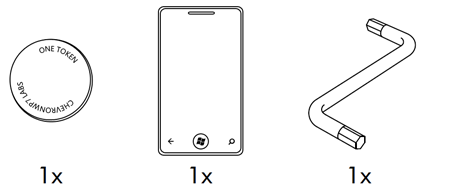
The creators of smartphone platforms have to perform an unusual balancing act. Every platform now has a first-party application store of some kind. But each platform makes its own set of particular trade-offs, weighing up openness and accessibility, protection from malware, and prevention of piracy. With the release of the independently-developed but Microsoft-authorized ChevronWP7 homebrew tool, Redmond is trying to strike a new balance with Windows Phone.
The two dominant smartphone platforms, iOS and Android, have very different approaches to software development. On the one hand, we have Apple's thoroughly locked down iOS platform. Unlocking a phone to allow software development requires a $99/year fee paid to Apple. There's no provision for developing or distributing applications without this payment, even as hobbyists, and all distribution that does occur must meet Apple's rules and guidelines.
As a result, there's a thriving jailbreak community. People actively seek out security holes in iOS to liberate themselves from Apple's restrictions and install applications that haven't been blessed by Cupertino.
The Android ecosystem is in many regards the opposite extreme. Most Android phones include access to the Android Market, and most of these include the option to install applications from outside the Market. Some handset models do require a more iOS-like jailbreak in order to open them up, but for the most part there are no meaningful restrictions. Although developers can distribute via the Market (for a cost of $25), they don't have to. As a result, hobbyists and independent developers can easily deploy applications to their phones without limit.
But this comes at some cost: the free and unfettered access has contributed to a significant piracy problem on the platform. Sideloading pirated applications is generally straightforward and can be done on most Android phones. The Market itself is also something of a free-for-all; it's much less restrictive than Apple's App store, and has on many occasions been used to serve malware. The two issues are often combined, with pirated versions of applications used to distribute malware.
With the release last week of ChevronWP7, Microsoft may have found a middle ground for its Windows Phone platform. Microsoft's Marketplace follows the same model as Apple's App Store; $99 per year to sign up, with applications forced to comply with strict rules. ChevronWP7 provides an alternative. Developed by a trio of independent developers (Rafael Rivera, Chris Walsh, and Long Zheng) in conjunction with the software giant, ChevronWP7 allows hobbyists to unlock their phones and deploy homebrew applications for $9.
Behind the scenes, it taps the same unlocking and authentication system that Microsoft uses for regular developer handsets. This makes its unlocked phones functionally identical to those phones unlocked for the $99 dev fee. The only difference is the ability to use Marketplace. For $99, developers can submit applications for Marketplace. For $9, they can't.
What about piracy?
The ChevronWP7 developers tell Ars that initial interest in the tool has been much higher than expected, with the service overloaded and backlogged since its launch.
Even before ChevronWP7 hit the scene, some Windows Phone applications were distributed as side-loadable packages. To install these, users either had to buy the full developer unlock or else track down ChevronWP7's predecessor, also called ChevronWP7. That program was released late in 2010 but was pulled at Microsoft's request a few days later amidst piracy concerns.
Those piracy concerns are still an issue. It's possible to download application packages from Microsoft's servers and install them onto a developer unlocked phone without actually buying them.
That will change. Windows Phone 7.5 "Mango" includes support for a new kind of encrypted package that should rule out this kind of piracy. Microsoft is waiting to ensure that a high enough proportion of users have upgraded to Mango before throwing the switch and using these encrypted packages, however.
Microsoft's old Windows Mobile platform, which had no restrictions at all, enjoyed a substantial homebrew developer community. That community was largely displaced by Windows Phone, due to the Marketplace restrictions, leaving the (rare) fans of that platform disappointed and looking elsewhere for their smartphone needs. In backing ChevronWP7 and re-engaging with this homebrew community, Microsoft is welcoming these long-time supporters back into the fold.
In the grand scheme of things, supporting ChevronWP7 is only a minor thing, but it shows how Microsoft is trying to differentiate itself from the competition. It takes the best features from other platforms—the safety and security of iOS, the ease of access of Android—all combined with Microsoft's unparalleled developer outreach and engagement. Actions like this won't on their own be enough to make Windows Phone a success to rival iOS or Android, but they certainly can't hurt.
Is ChevronWP7 enough to satisfy every hobbyist and homebrew developer? Probably not. Just as Marketplace applications are subject to various restrictions—for example, they can't use certain kinds of native code or access the phone's filesystem—so too are ChevronWP7 applications. While these limitations are understandable for Marketplace applications both for security and compatibility reasons, it would be better if Microsoft provided a way for homebrewers to relax the limits and truly make their devices their own.
Locked-down environments have numerous advantages for consumers, but these sealed systems bring with them a certain loss of freedom. Though it could go further, ChevronWP7 goes a long way towards restoring that freedom without jeopardizing the security that restrictions bring.
reader comments
63